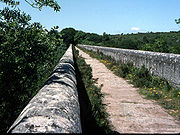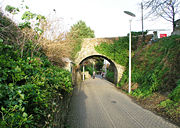
Treffry Tramways
Encyclopedia

Horse
The horse is one of two extant subspecies of Equus ferus, or the wild horse. It is a single-hooved mammal belonging to the taxonomic family Equidae. The horse has evolved over the past 45 to 55 million years from a small multi-toed creature into the large, single-toed animal of today...
worked mineral tramways
Tramway (mineral)
Tramways are lightly laid railways, sometimes worked without locomotives. The term is in common use in the United Kingdom, New Zealand, and elsewhere. In New Zealand, they are commonly known as bush tramways...
in Cornwall
Cornwall
Cornwall is a unitary authority and ceremonial county of England, within the United Kingdom. It is bordered to the north and west by the Celtic Sea, to the south by the English Channel, and to the east by the county of Devon, over the River Tamar. Cornwall has a population of , and covers an area of...
in the United Kingdom
United Kingdom
The United Kingdom of Great Britain and Northern IrelandIn the United Kingdom and Dependencies, other languages have been officially recognised as legitimate autochthonous languages under the European Charter for Regional or Minority Languages...
. They were named after the man principally responsible for their construction, Joseph Treffry
Joseph Treffry
Joseph Austen Treffry was an engineer, mining adventurer, and industrialist who became a significant landowner in Cornwall, United Kingdom.-Biography:...
(1782-1850), a local land owner and entrepreneur. At their maximum extent, the Treffry Tramways consisted of two separate main lines. One of these, sometimes called the Par Tramway, linked Par with Bugle
Bugle, Cornwall
Bugle is a village in central Cornwall, United Kingdom. It is in the parish of Treverbyn and is situated about five miles north of St Austell on the A391 road....
in the central Cornwall china clay
Kaolinite
Kaolinite is a clay mineral, part of the group of industrial minerals, with the chemical composition Al2Si2O54. It is a layered silicate mineral, with one tetrahedral sheet linked through oxygen atoms to one octahedral sheet of alumina octahedra...
district. The other, sometimes called the Newquay Railway, linked Newquay with the lead mines near Newlyn East, and with Hendra
Hendra
Hendra may refer to:People* Hendra Aprida Gunawan , male badminton player* Hendra Setiawan , badminton player* Imay Hendra, badminton player* Tony Hendra , British actor and authorOther* Hendra, Cornwall...
in the china clay district.
It was always Treffry's intent to create a connection between the two lines and thus link Newquay, on Cornwall's northern coast, with Par
Par, Cornwall
Par is a town and fishing port with a harbour on the south coast of Cornwall, England, United Kingdom. The town is situated in the civil parish of Tywardreath and Par and is approximately east of St Austell. Par has a population of around 1,400.....
, on the south coast. However this was not achieved in his lifetime, nor by the Treffry Tramways in their original form. They were eventually taken over by the Cornwall Minerals Railway
Cornwall Minerals Railway
The Cornwall Minerals Railway operated a network of railway lines in Cornwall, United Kingdom. Based at St Blazey, its network stretched from Fowey to Newquay and lasted as an independent company from 1874 to 1896, after which it became a part of the Great Western Railway.-Authorisation:The...
, which rebuilt them for locomotive
Locomotive
A locomotive is a railway vehicle that provides the motive power for a train. The word originates from the Latin loco – "from a place", ablative of locus, "place" + Medieval Latin motivus, "causing motion", and is a shortened form of the term locomotive engine, first used in the early 19th...
haulage and bridged the gap between the two networks, besides building several extensions. Today stretches of the tramway route are still in use by the Atlantic Coast Line
Atlantic Coast Line, Cornwall
The Atlantic Coast Line is a community railway line in Cornwall, United Kingdom. The line runs from the English Channel at Par, to the Atlantic Ocean at Newquay.-Route:The Atlantic Coast Line starts from Par station, in the village and port of Par...
between Par and Newquay.
History
Joseph Treffry's first transport constructions in Cornwall were not tramways, but rather Par Harbour and the Par Canal that connected the harbour to Pontsmill at the foot of the Luxulyan Valley. A narrow gaugeNarrow gauge
A narrow gauge railway is a railway that has a track gauge narrower than the of standard gauge railways. Most existing narrow gauge railways have gauges of between and .- Overview :...
cable hauled incline railway
Cable railway
A cable railway is a steeply graded railway that uses a cable or rope to haul trains.-Introduction:...
connected Pontsmill with his Fowey Consols mine
Fowey Consols mine
Fowey Consols mine is a group of mines in the St Blazey district of Cornwall. They were owned by wealthy Cornishman, Joseph Treffry. The mines were worked by 6 steam engines and 17 waterwheels. The mines were linked to the port at Par by a canal...
, one of the deepest, richest and most important of the Cornish copper
Copper
Copper is a chemical element with the symbol Cu and atomic number 29. It is a ductile metal with very high thermal and electrical conductivity. Pure copper is soft and malleable; an exposed surface has a reddish-orange tarnish...
mines, situated to the east of Pontsmill. Other inclines to the mine followed, and it is likely the various mine areas were linked by horse drawn tram lines. The mine was worked out and its associated lines closed by 1865.
Treffry died in 1850, but his tramways continued to run. By the 1870s they were one of the few significant horse hauled lines left in the country. The Cornwall Minerals Railway was authorised by Act of Parliament on 21 July 1873 to acquire the lines, connect them together and make them suitable for operation by steam locomotive.
Par Railway

Standard gauge
The standard gauge is a widely-used track gauge . Approximately 60% of the world's existing railway lines are built to this gauge...
, and was built for horse haulage. It commenced with a steep initial cable hauled incline, and then followed the contour line
Contour line
A contour line of a function of two variables is a curve along which the function has a constant value. In cartography, a contour line joins points of equal elevation above a given level, such as mean sea level...
s on the east rim of the Luxulyan Valley
Luxulyan Valley
The Luxulyan Valley is the steep sided and thickly wooded valley of the River Par, situated in the south east of Cornwall, England. It contains a major concentration of early 19th century industrial remains, and was designated as part of a World Heritage Site in 2006.The valley stretches south-east...
, before crossing the impressive Treffry Viaduct
Treffry Viaduct
The Treffry Viaduct is a historic dual-purpose railway viaduct and aqueduct, located close to the village of Luxulyan, Cornwall, England in the United Kingdom...
to Luxulyan
Luxulyan
Luxulyan , also spelled Luxullian or Luxulian, is a village and civil parish in central Cornwall, United Kingdom. The village lies four miles northeast of St Austell and six miles south of Bodmin...
and Bugle. A branch just before the Treffry Viaduct served several granite
Granite
Granite is a common and widely occurring type of intrusive, felsic, igneous rock. Granite usually has a medium- to coarse-grained texture. Occasionally some individual crystals are larger than the groundmass, in which case the texture is known as porphyritic. A granitic rock with a porphyritic...
quarries in the area.
In 1855 the Pontsmill to Bugle line was extended to Par Harbour alongside the Par Canal, thus removing the need to tranship goods at Pontsmill. In 1870 another branch line was constructed up the Luxulyan Valley from Pontsmill, this time following the valley floor and serving two other granite quarries in the valley.
Newquay Railway

Newquay
Newquay is a town, civil parish, seaside resort and fishing port in Cornwall, England. It is situated on the North Atlantic coast of Cornwall approximately west of Bodmin and north of Truro....
Harbour to Hendra, (St Dennis) with a branch to the East Wheel Rose lead mine near Newlyn East. This line was authorised by Act of Parliament
Act of Parliament
An Act of Parliament is a statute enacted as primary legislation by a national or sub-national parliament. In the Republic of Ireland the term Act of the Oireachtas is used, and in the United States the term Act of Congress is used.In Commonwealth countries, the term is used both in a narrow...
in 1844 and completed in 1849. The line followed the same pattern as the Bugle line, with a steep cable hauled incline up from the quayside at Newquay Harbour, followed by lines with gentle gradients suited for horse haulage. There were three tunnels on the line; one at Newquay Harbour, one at Coswarth and the longest one known as Toldish Tunnel
Toldish Tunnel
Toldish Tunnel was built by Joseph Treffry as part of his mineral tramway from Newquay which opened in 1849. This line was built to carry trams. In 1874 the line was taken over by the Cornwall Minerals Railway and the line from Newquay was extended to Par railway station...
.

